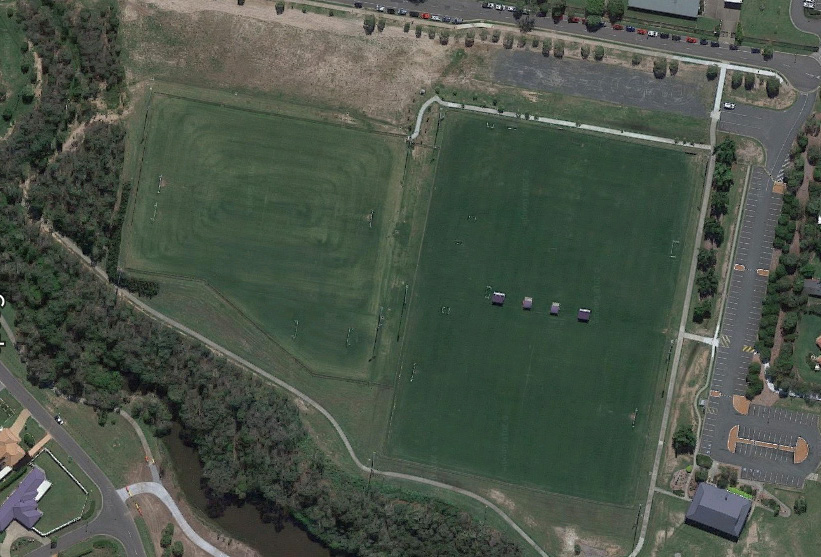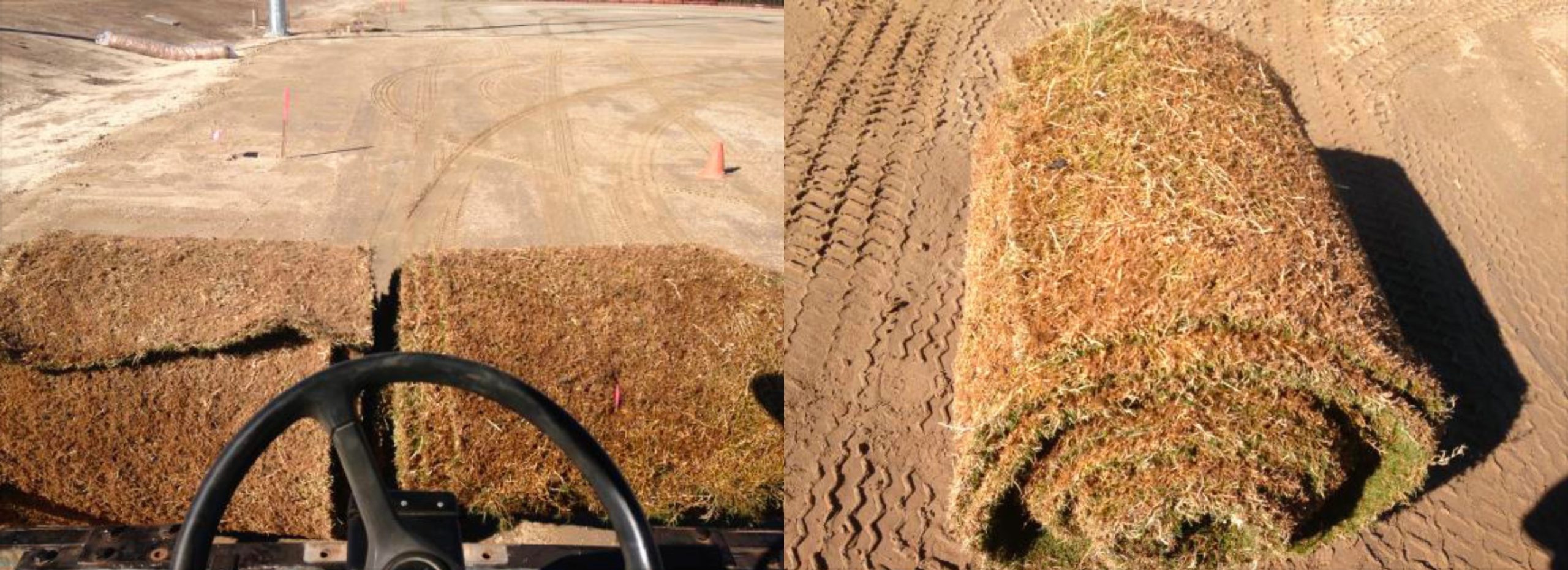Projects > Narangba Sports complex
Hancey’s Turf was sub-contracted by Naric civil ltd, to build one full size soccer field and one junior soccer field for Morton Bay Regional council. The project also included 15,000 square meters of turf in the surrounding areas.
This was to be a high specification new build field with designs similar
to fields constructed by Hancey’s Turf for Moreton Bay Regional Council at Samford sports precinct two years previously. The field specs and therefore high costing meant that stringent procedures and specific methodology had to be employed at all times to ensure the council got the very best results from they’re significant investment.
Mark Patterson, Project manager for Hancey’s Turf, was to oversee all works. Mark had already worked with the council and Naric Civil on the Samford project amongst others in the area successfully, building a solid understanding of the methodology and commitment to quality required.
The scope of works was carried out over the next two months, when the wet weather in S.E Queensland allowed and was as follows:
- The sub grade of the field base was handed over to Hancey’s Turf by Naric civil who had done the initial earthworks on site, to a tolerance of +/- 50mm. We were to grade the field to a more accurate +/- 10mm in an envelope shape so that the sub grade drained in all directions from the centre. The falls were set at 1 in 70m or 1.4%, this being slightly steeper than a standard field as no drainage was to be included in the sub grade.
- The subgrade was then ripped to 300mm, Gypsum included into the profile, then rotary hoed to achieve an even incorporation and small particle sizes to re grade. We applied Gypsum (calcium sulphate) to the surface for its beneficial characteristics. While Lime (calcium carbonate) is often used in agriculture as a soil enhancing substance, it can also dramatically raise the P.H which in our case could possibly hinder good turf growth. Gypsum is a more naturally occurring mineral. It provides calcium and sulphur, both essential nutrients, but does not affect soil P.H. It is typically a neutral salt (ph. 6.7) and has a salt index, or osmotic potential, of 8. The sulphur is in a plant available, or sulphate form. In addition to providing needed nutrients, the calcium in gypsum is soluble, even at a P.H that is >7. Thus it is very helpful in improving soil tilth, reducing soil compaction and improving aeration, all important factors to consider in a field with no drainage.
- The fields were now graded back to within +/-10mm. This was the first of many Hold Points for the council to assess and document the works. The field was surveyed on a 10m x10m grid to measure the ground levels were to specification and inside the tolerance. Once passed we were able to begin ordering and importing the top soil.
- Project Irrigation, the irrigation contractors, now took control of the fields for 3 days to install the pop up irrigation system and handed it back to Hancey’s once all checks on the system had been passed. Tolerances were re checked at this stage.
- A 250mm thick layer of topsand growing medium was to be placed without unnecessary compaction onto the sub grade. This was achieved by forming a platform in one corner of the field and a small Drott and Dozer were employed to push the material out from there. While this was a slow procedure, this methodology was essential to ensure the imported material was not compacted, there was no contamination of materials and the sub grade remained de- compacted after the ripping and gypsum application as no machinery was allowed onto it. Some six thousand tonnes of material were imported and pushed out over the 12500 square meters of adult and junior fields. The 90% sand, 10% peat moss material was brought to and dropped on site by approximately 180 truck and dogs over a 5 day period, meaning all materials could be pushed out within 6 days. Hancey’s Turf then employed a tractor and laser bucket to grade the material to within +/- 5mm, this taking two days to be as accurate as possible as all levels now had to come within a +/- 5mm tolerance on a 5m x5m grid survey.
- Project Irrigation, the irrigation contractors, now took control of the fields for 3 days to install the pop up irrigation system and handed it back to Hancey’s once all checks on the system had been passed. Tolerances were re checked at this stage.
- After tolerances had been passed by the council survey, a series of compaction tests (“clegg hammer testing”) were completed to assess infiltration rates and compaction levels had not been affected during placement and laser grading. All tests revealed minimum compaction and adequate water movement through the profile so we were able to begin the turfing component of works. Specifications required washed rolls ‘Wintergreen’ couch grass, turf measuring 1.2m by 20m long. Hancey’s Turf are able to set specialist machinery to meet any specifications when harvesting turf from they’re Woodford farm base. Here the turf is also washed using our own high pressure turf washer and in one pass all soil is cleanly removed, maintaining quality of turf and ensuring there can be no contamination of materials once the turf is layed. This procedure is highly recommended for all high profile sports ground construction especially sand based fields and cricket wicket blocks. 2500 square meters of turf was harvested, washed, delivered to site and layed per day meaning the field was completed within a week by Hancey’s laying team to the high standards required. The field was rolled in several directions to bed the turf in, essential when working with washed turf, fertilised and watered heavily. Mark Patterson set the watering program to irrigate 5 times daily at this early stage. When working with washed turf it is paramount that the top surface (leaf of the plant) is kept moist as the turf has no soil to gain moisture from until roots establish a week after turfing. Constant assessment is required for the first 10 days until root growth occurs, then watering is slowed gradually before eventually set to just twice weekly so that root growth and root depth is encouraged to increase significantly.
- The surrounds; original site soil was used to level and grade the field surrounds, thus saving the cost of importing more material. Some 15,000 sqm of surrounds were levelled and turfed with standard slabs of ‘wintergreen’ couch. Paths, a car park, fencing and swale drains were built to council specifications and plans to ensure the site was ready for public use.
- TOP-DRESSING – Four weeks after the turf was laid, and after the field had been mowed twice, we top-dressed the field. I used a 90% sand to 10% soil and peatmoss top-dressing blend, which is standard industry practice but also the exact same material used during construction. The aim of top- dressing is even out any imperfections in the turf and help the turf joins to knit together. The material is spread using a tractor pulling a large spreading hopper then rubbed in with a drag mat. 120 cubic meters of material was used (or 150 tonne) which gave a 10mm layer over the surface.
- A Fertilising program is now in place as is regular mowing, weed monitoring, aeration and watering, all managed by Hancey’s Turf as per the 40 week grow in and maintenance contract with the council. The field is to be opened and used by the general public, 12 weeks after the turf was layed.
General practice
- All earth works were completed in dry, suitable conditions to remove the risk of contamination to the field, minimise compaction by machinery and delivery trucks on surrounding areas and eliminate the risk of mess being caused by vehicles leaving the site.
- All turf for the job was harvested from the same paddock ensuring that a consistent strain of ‘wintergreen’ Couch was used.
- Turf had to be harvested, washed and layed within a 24 hr. period to ensure it was in maximum health once layed, had good colour and was consistent from start to finish.
- The turf was inspected on the farm by council representatives to ensure was of the quality required.
- A series of tests were carried out at various stages when importing materials for the top grade to ensure consistency and quality of product.
- All works completed met council approval and industry standards throughout, passing various hold points, health and safety requirements and environmental considerations.





